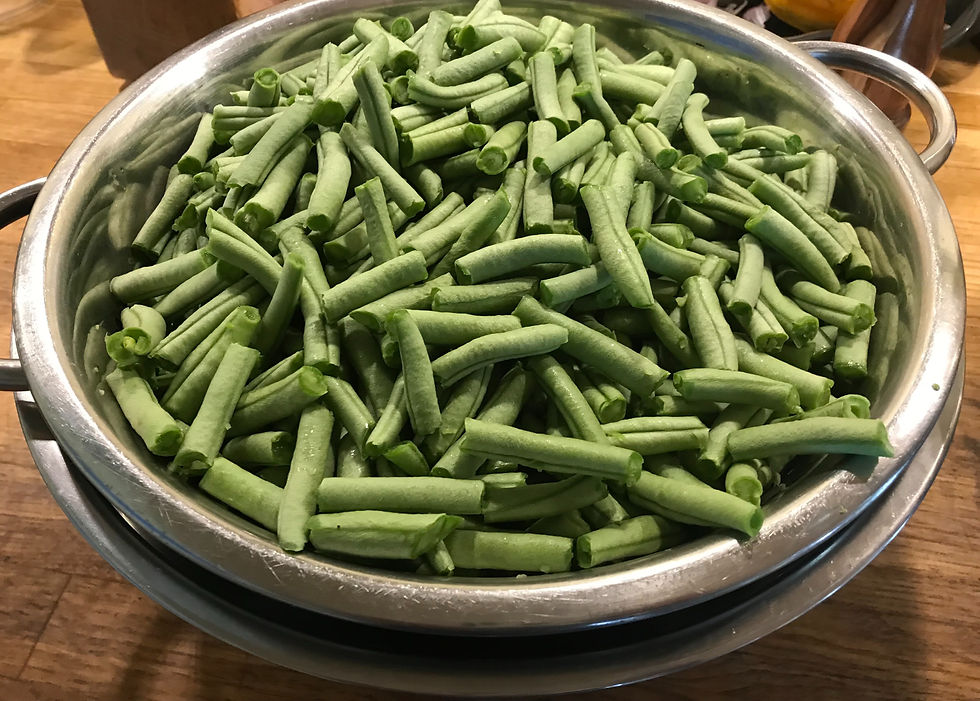Staying Ahead of the Game at Harvest Time
- Jared Regier
- Oct 1, 2024
- 7 min read
At some point, every vegetable gardener will have the experience of walking out into their garden and realizing that they have a ton of food to harvest and next to no time to deal with it. If your garden size has already crept up to 500 - 1000 square feet or beyond, then odds are good you've already had this experience. Since I have a background in market gardening, managing up to 10000 square feet of vegetable gardens on my own, I have faced this same dilemma many times. In my younger years, I overcame the problem with surges in my work volume that would match the harvesting requirements, but these days I like to work smarter, not harder. So today, I navigate the harvest rush with logic. This logic has always helped me come out on top, even when it feels like there just isn't enough time to do everything I need to do.
I think of this logic as my harvest triage and I'm going to break it down for you today, so that in a few minutes from now, you'll be able to apply the same way of thinking to navigate the best path through your busy harvest season. Before I share this logic though, I should provide a bit of context about our growing conditions because yours will likely be a little different. Here on the Canadian prairies, the harvest period for our outdoor vegetables begins in June and usually wraps up sometime in October. Throughout these months there are times when we only need to be concerned with a steady trickle of food coming out of the garden, and other times when production surges and we need to be prepared to handle the rush. Autumn is one of the times when we have a very large surge of produce to deal with and added to this is the pressure of our plummeting temperatures, which will inevitably bring our gardens to a frosty finish. It's autumn right now for us. Yet, I am still taking time to write this article for you, so take that as a sign that my prioritization strategy really does work.
So, where should we start? That is the question isn't it. Your fall garden may be packed with hundreds of pounds of food all calling out for your attention, but it's not always clear which task to tackle first. Sometimes, I make to-do lists to help me manage busy periods of the growing season, but I can't give you my to-do lists because your garden and growing conditions are unique to you. What I can give you is a process to make your own to-do list and identify which tasks on that list are the most important. Then you'll be able to use the same process to confidently combat any harvesting overwhelm that you may be feeling.
I think I've managed to condense all of the complexity behind this decision making process into three words, two questions, and one diagram, so that's where we'll start today. The short animation below will show you how these three words and two questions can be organized to rank 6 priorities from the most important to least important. The rest of this post will clarify each of these 6 priorities with a few examples.
Occasionally, I will make a to-do list to get my tasks on paper and out of my mind, but there's no fancy scheduling app required. I just need to remain committed to regularly spending a bit of time on garden related tasks and eventually everything will get crossed off my list in the right order...as long as I stick to the 6 priorities on the diagram above and avoid getting distracted. : )
How can I maintain value?
If you were the captain of a ship that had just sprung a leak, all of your other priorities would immediately become secondary to fixing this leak. Similarly, if I see that something in my vegetable garden is about to lose its value, it immediately becomes the number one priority.
Often the quickest way for me to preserve the value of a crop, especially as temperatures drop in fall, is to protect the crop from cooling temperatures. That's why PROTECT is the first step. An example of this action would be to pull out a frost blanket to cover some tomatoes in order to protect them from cool or freezing night temperatures. I may not have the time or need to harvest the tomatoes yet, but I can quickly cover them to preserve their value and free up time for dealing with more urgent tasks.

Once everything in our garden is protected, I can proceed to HARVEST, but which crops should I harvest first? It makes the most sense to focus on the crops that are the most vulnerable to the cooling temperatures. For example, if there were freezing temperatures in the forecast, and I had to choose between harvesting peppers or carrots, it would make the most sense to harvest the peppers to preserve their value because carrots can handle light frosts without losing any value. I know its not obvious which crops can tolerate the coldest temperatures. You can acquire this knowledge through experience, observation, and research. Seed to Table course members can just reference the growing temperatures table in the Season Extension lesson found here in Module 5.

If all of my most pressing harvesting tasks are complete, I can start to PRESERVE my harvested food as needed. We enjoy eating lots of our food in its fresh state as it's coming out of the garden and we have a large cold storage space so that's why the preserve action is only ranked as the third priority. Typically, we'll move our harvested crops directly into a storage space and only start preserving when we absolutely need to. For example, whenever we harvest beans, we just put them in our cooler to begin with. We'll enjoy lots of them fresh with our meals for a few weeks first, and only after that initial storage period, will we fire up our preservation efforts to blanch and freeze any remaining beans for the winter. So with this first preserve action, we are really just surveying our stored crops and assessing whether any of them need to by preserved immediately (ie. canned, dehydrated, or frozen) so that they don't lose their value.

How can I get ahead?
If we only ever get through these top 3 priorities in the time we have, then we may just make it through to the end of the season, but I've learned that it's pretty easy to underestimate the amount of harvesting work remaining, and our fall weather is less predictable, so if I've got time to spend on my garden tasks, it's best to get ahead while I can. The last three priorities deal with the same tasks of preserving, harvesting, and protecting, but in reverse order.
The most logical place to get ahead is in the task of preservation, so PRESERVE is priority four also, but now the guiding question is "How can I get ahead?" not "How can I preserve value?" With this in mind, we start to look at areas like our shelves of tomatoes, which may all be in fine shape, but we know this state isn't going to last very long and there's no chance we'll be able to eat them all in their fresh state. We can get ahead of the game by starting to preserve them because we know that task is imminent and if I do it when it's not an urgent priority, it will free up time in the future for other tasks that need to be the priority later on.

The next place we can get ahead is with some harvesting so we come back to HARVEST as our fifth priority. With thoughts of getting ahead, we look at our remaining crops and to assess which are mature enough to be harvested and which have the best storage life once harvested. These are the crops that make the most sense to harvest earlier. The potato is one of these flexible crops. Once they are fully mature, the potatoes are can just sit in the ground as long as the ground doesn't freeze, but they also store really well. Therefore, this is one harvesting task that's nice to check off the list before it's urgent. On the other side of the spectrum, we have crops like kale or leeks that can really go the distance into cold fall temperatures. If I harvest those crops first, they will start to depreciate in quality in storage, and unlike the potatoes they are actually capable of growing more into fall and increasing our overall harvest.

Finally, we come full circle and finish with the sixth priority, which is to look for opportunities to PROTECT our crops once again. This is ranked last in our "How can we get ahead?" category because it's hard to protect crops too early. In fact, it's possible to make growing conditions worse by adding protection measures too early. For example, if I was imagining setting up a low tunnel to keep our greens from freezing and prevent any snow from crushing the leaves, it wouldn't make sense to set up that tunnel in late August. At this point, a closed tunnel would overwhelm the greens with excess heat and cause undue stress. Instead, I would start by adding a floating row cover to my beds of greens as temperatures start to dip, and I'd only bring out the low tunnel once we approach the bitter end. If I know this is coming, maybe I take some time to get ahead by setting up the tunnel hoops, and even strap on the plastic but leave the tunnel open until it's really needed to protect the crop or enhance growing conditions.

With the 6 priorities described in harvesting triage, you have everything you need to blast through any harvesting crunch in the most logical order and take the fewest losses from frost or missed harvests along the way, but it's possible that this logic won't solve all of your problems. If you follow these 6 steps and still find that you are not able to keep your head above water, it doesn't mean that you have failed at gardening or that you need to quit your job in order to keep up with your gardening tasks. It just means that you have a planning problem, and not a decision making problem. Somehow, you managed to start a garden that wasn't fully aligned with your interests or management capabilities. You're not the first person to make this mistake and there's no need to take this as bad news, because you don't need to change yourself or your lifestyle in order to start growing your own food. You just might benefit from a little guidance during the planning of your garden so that the growing space you create is compatible with the way you live your life. I suggest starting with this free 2 minute quiz to help identify the types of vegetables that would be best for you to grow, and if you're serious about mastering this vegetable game quickly, join our Seed to Table course community and shave years off of your learning curve.




























































































